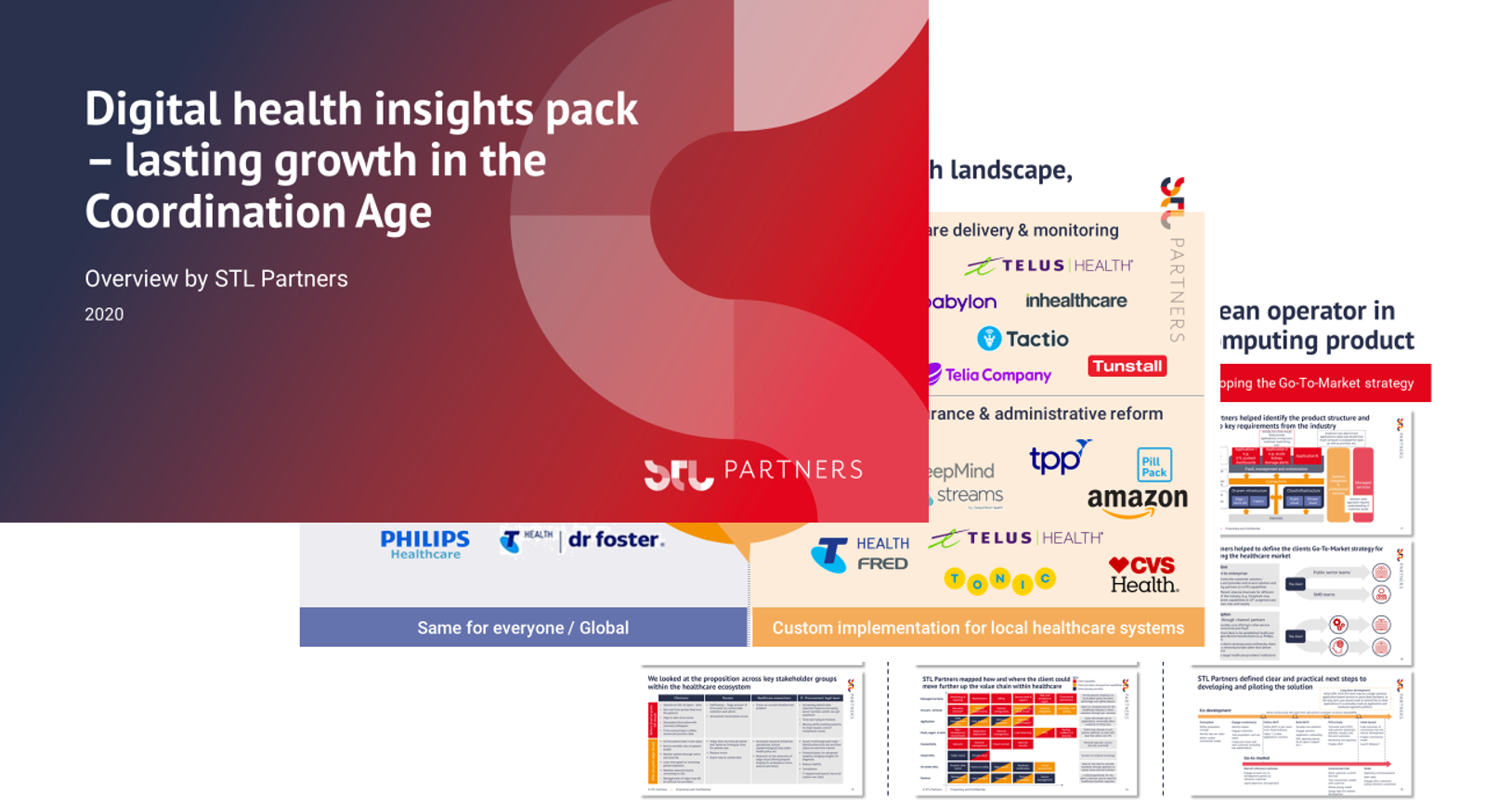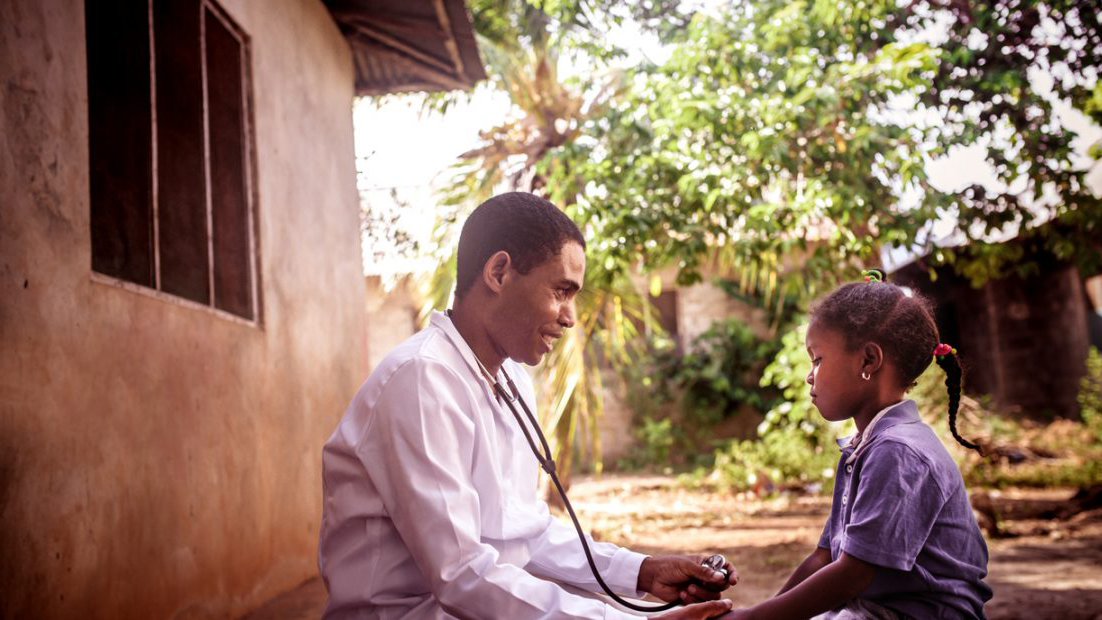15 Digital Health companies to watch in 2021
In this article, we highlight 15 digital health companies (grouped by application area) who we think are companies to watch in 2021.
Who’s who in the digital health world
At the beginning of last year digital health was already a burgeoning industry, but the COVID-19 pandemic has cemented its importance within healthcare and society. Overnight, entire procedures migrated online to reduce social contact and transmission rates. Telemedicine has unsurprisingly profited from this healthcare paradigm shift, as patients seek care that can be delivered virtually within the confines of their homes (see our article “How COVID-19 is changing digital health – and what it means for telcos”).
While the pandemic has directed heightened attention (and investment) to digital health companies operating in telemedicine in particular, there are interesting things happening across all five application areas STL has identified as most relevant to telecoms operators (see our article “What is digital health? 5 application areas telcos should focus on”):
- Personal health management and wellness
- Diagnostics and triage
- Virtual care and telehealth
- Remote monitoring
- Data and analytics
In this article, we highlight 15 digital health companies (grouped by application area) who we think are companies to watch in 2021. They either have a unique value proposition or represent an opportunity for collaboration with a telecoms operator.
Our 15 digital health companies to watch
- Oura ring
- Vantage Health
- Mendelian
- Galileo Health
- Doctor On Demand
- Butterfly
- MedWand
- Peppy
- Maven Clinic
- Phlo
- PocDoc
- CareSimple
- Tunstall
- MyWay Digital Health
- Bleepa
1. Oura ring
Application area: Personal health management & wellness
End user: Consumer
Payer: Consumer
Website: www.ouraring.com
Founded: 2013
The Oura ring is a piece of wearable tech which uses sensor technology to track health vitals. It sends these data points to a mobile app through Bluetooth and allows the user to see metrics such as readiness for the day, quality of sleep and daily calories burnt.
While the Oura ring was created primarily to help the user build good habits, it is currently in the spotlight for its ability to detect the onset of COVID-19. While there are alternative smart rings, the Oura ring is best placed for this capability given its advanced sensors which measure temperature changes as small as 0.1°C. It is clearly meeting the immediate COVID-19 needs given that the NBA has bought more than 2,000 rings for players and staff in the hope to keep the pandemic at bay.
The Oura ring is priced between $299-$399, which means it is more expensive than most Apple watches (apart from the series 6 which starts at $399). While there are some key differences between an Oura ring and an Apple watch (e.g. Oura ring’s ability to measure body temperature), there are also overlapping functionalities (e.g. the tracking of sleep, the measuring of heartrate, and the flagging of irregular heart rhythm). Due to these similarities – not to mention Apple’s strong brand – Oura’s price point would need to come down for mass market adoption.
2. Vantage Health
Application area: Diagnostics & triage
End user: Clinician
Payer: Healthcare organisation
Website: www.vantage.health
Founded: 2004
Vantage Health is a digital health company transforming the outpatient referral process through its AI platform, Rego. This empowers clinicians to use healthcare resources more efficiently: rather than directing patients to hospitals by default, they can suggest alternate care services (e.g. community services) based on local guidelines.
As hospitals have limited resources and capacity, it is important to refer only those when most necessary and thus avoid patient bottlenecks (long queues and high waiting times). This is particularly important amid COVID-19 due to the transmission risk associated with crowds. Through Rego, Vantage Health can alleviate some of the pressure and strain that hospitals face.
3. Mendelian
Application area: Diagnostics & triage / Data & analytics
End user: Clinician
Payer: Healthcare organisation
Website: www.mendelian.co
Founded: 2015
Mendelian is an AI-enabled diagnostics platform that is centred around rare diseases. It is designed to be used by clinicians and enables them to better serve their patients through early diagnosis. The MendelScan algorithm captures disease features from EHRs across a patient population, against which patients are matched for diagnostic criteria of rare diseases. Clinicians can combine their medical expertise with insights from the MendelScan, thus improving the accuracy of care and advice they provide.
Rare diseases are often misdiagnosed, resulting in unnecessary referrals and doctor visits, an interval of numerous years before correct diagnosis and excess cost on healthcare systems. By facilitating early diagnosis of rare diseases, Mendelian can save time and money for a healthcare system that is already over-stretched.
4. Galileo Health
Application area: Virtual care & telemedicine
End user: Patient
Payer: Patient, employer
Website: www.galileohealth.com
Founded: 2018
Galileo Health is a healthcare app through which virtual primary care is delivered. Members have 24/7 mobile access to Galileo Health’s team of medical experts, who can diagnose conditions, prescribe drugs and refer to specialists. All these functionalities happen within the app, making it user-friendly and convenient.
Telecoms operators seeking to launch a virtual primary care service can accelerate their go-to-market through partnerships with digital health companies like Galileo Health, as TELUS has done with Babylon Health and Telefónica with Teladoc. In this type of partnership, each party brings complementary skills to the table: Galileo Health has the software, healthcare knowledge and team of doctors; a telecoms operator adds reputational strength (being a trusted brand within countries and often with ties to authorities / regulators) and customer reach. With a blueprint and lessons from TELUS’ collaboration with Babylon Health now available, we can expect to see more partnerships of this kind in the future.
5. Doctor On Demand
Application area: Virtual care & telemedicine
End user: Patient
Payer: Patient, employer, insurer
Website: www.doctorondemand.com
Founded: 2012
Doctor On Demand is a digital health company providing telemedicine services that give patients access to virtual care. The company has an app in which virtual visits take place, and a team of licensed physicians (known as “Doctor On Demand Professionals”) which handles the care services. Doctor On Demand’s healthcare offering is broad: they cover traditional primary care such as rashes and colds, but also provide psychiatrists, psychologists and therapists. The comprehensiveness of their services explains their slogan: Total Virtual Care.
Similar to Galileo Health, Doctor On Demand can accelerate the go-to-market of telecoms operators seeking to launch a virtual primary care service. There is, however, a differentiating factor between these healthcare companies: breadth of offering. Doctor On Demand may be an attractive digital health company to telecoms operators as it would allow them to quickly diversify their care services – they could do POCs with one service line (e.g. traditional primary care), and if this proves successful, add other Doctor On Demand service lines to their offering.
6. Butterfly
Application area: Virtual care & telemedicine
End user: Clinician
Payer: Healthcare organisation
Website: www.butterflynetwork.com
Founded: 2011
Butterfly is a handheld portable ultrasound machine which utilises ground-breaking chip technology. With just this machine and a smart phone, doctors can perform ultrasound scans. Butterfly has five imaging modes and comes with 20 presets of common body scans for abdomen, bladder and lungs.
Butterfly has a unique value proposition given its proprietary technology: it is the first whole-body imager that is portable, affordable (£1,699 for the machine plus a yearly membership fee of £360) and can be deployed at scale. This type of machine is well suited to bringing medical imaging to rural communities. Moreover, as images can be shared and sent for review, Butterfly overcomes the lack of specialists in remote areas. While Butterfly is a game-changer in low-resource settings, it is also being used in clinical environments – earlier this year it was made available to Canadian healthcare practitioners and health systems.
7. MedWand
Application area: Virtual care & telemedicine
End user: Patient, clinician
Payer: Patient, healthcare organisation
Website: www.medwand.com/whymedwand.html
Founded: 2014
MedWand is a medical device which enables patients to perform physical exams, expanding the range of consultations that can take place virtually. With MedWand, patients can carry out exams on themselves that GPs would typically perform, such as listening to lungs, measuring blood oxygen levels and inspecting skin.
Patients use the MedWand while on a call with a clinician so that they can be accordingly guided, thereby ensuring accuracy of results. The clinician can then analyse the results in real-time, provide feedback and create a care plan. All this happens within the MedWand platform, which is compatible with EMR systems and acts as the intermediary space between patients and telemedicine providers.
8. Peppy
Application area: Virtual care & telemedicine
End user: Patient/consumer
Payer: Employer
Website: www.peppy.health
Founded: 2018
Peppy is an app that supports employee healthcare and wellbeing. Within the app, employees can choose the stream of service they require (Healthy Mind, Menopause, Parenthood, Fertility), and then they can speak to an array of advisers and practitioners. Communication channels within Peppy are both text- and video-based and provide access to resources and toolkits.
COVID-19 has shone a light on the importance of employee mental health. Moving forward, even when the pandemic has become a thing of the past, employers will have to cater to holistic wellbeing. Peppy as a digital health company is set to benefit from these changing attitudes.
9. Maven Clinic
Application area: Virtual care & telemedicine
End user: Patient/consumer
Payer: Patient/consumer, employer, insurer
Website: www.mavenclinic.com
Founded: 2014
Maven is a digital health company providing telemedicine services that revolves around care for women and families. Members of Maven are assigned dedicated Care Advocates, can book on-demand appointments (video-based), and receive personalised educational content. These multiple touchpoints mean that members feel supported whatever their concern (e.g. parent planning, egg freezing, adoption, childcare support).
By offering Maven, employers ensure that employees have the right support system in place for all paths to parenthood. This attracts and empowers female and LGBTQ+ employees. Maven enables employee benefits to reflect the diversity of the workforce.
This type of digital health company can be an important partner for telcos operating in countries with hybrid or privately funded healthcare systems. As large employers, they can trial and develop these solutions for their own employee base before exploring new business opportunities.
10. Phlo
Application area: Virtual care & telemedicine
End user: Patient
Payer: Healthcare organisation
Website: www.wearephlo.com
Founded: 2015
Phlo is a digital pharmacy which enables prescription drugs to be ordered online and delivered direct to homes. This eliminates the hassle that often accompanies visits to physical pharmacies: long queues and stock shortages. Through Phlo, patients can order and receive their medication on the same day. The app makes the patient experience seamless as everything happens in one place, from requesting GP approval for medication, to choosing the delivery address and tracking the order in real-time (real-time tracking is currently only live in London but Phlo is planning to expand this feature to other major UK cities).
In April 2020 distance selling pharmacies accounted for just 3.2% of total prescriptions in the UK. But considering the impact of COVID-19 and the fact that traditional community pharmacies are pivoting their services to reduce pressure on GPs, we can expect this number to rise.
11. PocDoc
Application area: Virtual care & telemedicine
End user: Consumer
Payer: Consumer, employer
Website: www.mypocdoc.co.uk
Founded: 2016
PocDoc (Vital Signs Solutions is the parent company) is a digital health company and healthcare provider that combines rapid testing with a digital platform via the PocDoc app. While PocDoc can be used to test for COVID-19, its primary focus is on blood tests for cardiovascular disease and diabetes.
In light of the pandemic, PocDoc is offering workplace screenings for COVID-19. The company’s team of Healthcare Professionals brings everything required to operate the screening under guidelines, with a 10-minute turn around for results. As employees gradually return to the workplace in line with government guidance, companies like PocDoc may play a key role in maintaining safety and ensuring that the workplace stays open.
12. CareSimple
Application area: Remote monitoring
End user: patient, healthcare organisation
Payer: insurer (private healthcare), healthcare organisation (public healthcare)
Website: www.caresimple.com
Founded: 2009
CareSimple is a remote patient monitoring (RPM) solution provider, which enables healthcare organisations to quickly implement RPM programs. CareSimple handles all the steps from registration of a patient to enablement of RPM: they send 4G-enabled medical devices (blood pressure monitor, body weight scale, blood glucose monitor) to the patient and supply the healthcare organisation with a clinical portal through which services are delivered. While the healthcare organisation handles the services, it is also able to leverage CareSimple’s network of service providers.
The fact that CareSimple has its own network of service providers means that they offer a complete solution. They are therefore a viable partner for telecoms operators seeking to enter the digital health market as they facilitate quick deployment of RPM programs: telecom operators would not need to invest in hardware, software or service providers. An example partnership is in Sweden, where Telia has developed a remote monitoring ecosystem, called IBD home, using the CareSimple platform. Another opportunity for telecoms operators is to be the connectivity provider of the 4G-enabled medical devices.
13. Tunstall
Application area: Remote monitoring
End user: Patient/consumer, healthcare organisation, long term care
Payer: Patient/consumer, healthcare organisation, long term care
Website: www.tunstall.co.uk
Founded: 1957
Tunstall is a solution provider which supports those requiring care and health intervention to live independently in their chosen home setting. The offering is broad in scope and can be applied in numerous circumstances, from assisted living in retirement homes to chronic disease support and complex care management. Tunstall’s connected care solution is delivered through medical devices such as wearable fall detectors, bed occupancy sensors and a Smart Hub unit. In addition to this at-home med-tech, Tunstall provides a platform through which virtual care can be delivered and a fully outsourced service model where trained teams manage end-to-end care delivery.
Given Tunstall’s provision of an end-to-end solution, they are an attractive partner for telcos seeking to offer digital health services. Telcos would be able to leverage Tunstall’s diverse solution portfolio in line with their strategy: Connected Care, Connected Health, Connected Services. We are already seeing partnerships, for example in Spain where Telefónica and Tunstall have partnered to deliver an RPM solution.
14. MyWay Digital Health
Application area: Remote monitoring / Data & analytics
End user: Patient, clinician
Payer: Healthcare organisation
Website: www.mywaydigitalhealth.co.uk
Founded: 2017
MyWay Digital Health supports patients living with diabetes and clinicians treating diabetes. With respect to patients, MyWay Digital Health provides a platform which facilitates self-management: this includes the provision of care planning and goal setting, communication channels with clinicians and a wealth of educational resources.
For clinicians, MyWay Digital Health has developed a platform which integrates data across healthcare organisations and home-recorded data. The platform therefore provides a complete diabetes electronic health record and analytics platform. This empowers clinicians to make data-driven decisions and to deliver personalised patient management.
15. Bleepa
Application area: Data & analytics
End user: Healthcare organisation
Payer: Healthcare organisation
Website: www.fbkmed.com/bleepa-certified-imaging
Founded: 2019
Bleepa is a communications platform designed for medical staff in hospital settings. It combines secure, instant messaging with the ability to share clinical grade medical images (e.g. x-rays). This means that medical staff dispersed throughout a hospital location can review images, discuss points and come to collective decisions in an expedited manner. With any communications platform – particularly one that deals with sensitive healthcare data – there is always the question of privacy. As Bleepa is healthcare software, the hospital has responsibility for the data and its management.
Bleepa is available on the NHSx Clinical Communication Tools Framework. Amid COVID-19 and the pressure that hospitals are facing, communication tools that save time for medical staff, in turn speeding up care for patients, are critical.
So what for the telecoms industry?
The 15 Digital Health companies we have outlined above present players in the telecoms industry, who are looking to play in the digital health space, potential partnership opportunities to help the transformation and growth of their healthcare customers.
However, before engaging with any potential partners, telcos not only need to identify and prioritise which application areas they want to pursue but must also clearly define what role in the ecosystem they wish to play.

Once this has been defined, operators and technology vendors alike must identify the strategic partners that help them to fill the gaps in their capabilities and push forwards their ambitions in digital health – whether that be delivering end-to-end solutions to healthcare customers or providing a key layer in the value chain as part of a wider solution.
Author: Anthony Boyd, Consultant and member of the Digital Health Practice
Digital health insights pack
This 24-page document will provide you with a summary of insights from our healthcare research and consulting work:
- Key trends in the healthcare industry
- The role for telecoms: applications and business models
- Strategies for success: where to start
- How STL Partners can support you
Request the free digital health insights pack by clicking on button below:
![]()
Get in touch with our Digital Health Leads

Read more about digital health
Webinar
Telcos in health webinar
In this session Amy Cameron and Yesmean Luk looked at the opportunities for telcos in health. As a growing industry, with a national focus and significant digitisation challenges, healthcare is an attractive vertical for telcos seeking to build new revenues beyond core communications services.
Research
TELUS Health: Innovation leader case study
Healthcare is an attractive vertical for telcos to address with digital solutions. Although many telcos have made attempts to capture this opportunity, TELUS stands out as an example of the value of a long-term commitment to healthcare. In this case study, we examine TELUS’ strategy in health, evidence of its success, and draw out lessons for other telcos






